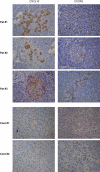Islet inflammation and CXCL10 in recent-onset type 1 diabetes
- PMID: 20059481
- PMCID: PMC2819499
- DOI: 10.1111/j.1365-2249.2009.04087.x
Islet inflammation and CXCL10 in recent-onset type 1 diabetes
Abstract
Type 1 diabetes results from a T cell-mediated destruction of insulin-producing pancreatic beta cells. Little is known on local factors contributing to migration of T cells to pancreatic tissue. We recently demonstrated evidence of viral infection in beta cells in several recent-onset type 1 diabetes patients. Islet inflammation was analysed in a series of new- or recent-onset type 1 diabetic patients and non-diabetic control subjects. Autoimmune T cell reactivity was studied in lymphocytes derived from pancreas-draining lymph nodes of one recent-onset type 1 diabetes patient in partial clinical remission. Insulitic lesions were characterized by presence of beta cells, elevated levels of the chemokine CXCL10 and infiltration of lymphocytes expressing the corresponding chemokine receptor CXCR3 in all pancreatic lesions of type 1 diabetes patients, regardless of enterovirus infection of beta cells. CXCR3 and CXCL10 were undetectable in pancreata of non-diabetic control subjects. T cells isolated from draining lymph nodes of a recent-onset patient with virally infected beta cells and in clinical remission reacted with multiple islet autoantigens and displayed a mixed interferon (IFN)-gamma/interleukin (IL)-10 cytokine pattern. Our data point to CXCL10 as an important cytokine in distressed islets that may contribute to inflammation leading to insulitis and beta cell destruction, regardless of local viral infection. We demonstrate further pro- and anti-inflammatory islet autoreactivity, indicating that different adaptive and innate immune responses may contribute to insulitis and beta cell destruction.
Figures



Similar articles
-
Enterovirus infection, CXC chemokine ligand 10 (CXCL10), and CXCR3 circuit: a mechanism of accelerated beta-cell failure in fulminant type 1 diabetes.Diabetes. 2009 Oct;58(10):2285-91. doi: 10.2337/db09-0091. Epub 2009 Jul 29. Diabetes. 2009. PMID: 19641142 Free PMC article.
-
Th1-Like ICOS+ Foxp3+ Treg Cells Preferentially Express CXCR3 and Home to β-Islets during Pre-Diabetes in BDC2.5 NOD Mice.PLoS One. 2015 May 6;10(5):e0126311. doi: 10.1371/journal.pone.0126311. eCollection 2015. PLoS One. 2015. PMID: 25946021 Free PMC article.
-
Gut dysbiosis promotes islet-autoimmunity by increasing T-cell attraction in islets via CXCL10 chemokine.J Autoimmun. 2023 Nov;140:103090. doi: 10.1016/j.jaut.2023.103090. Epub 2023 Aug 10. J Autoimmun. 2023. PMID: 37572540
-
Chemokines as Drivers of the Autoimmune Destruction in Type 1 Diabetes: Opportunity for Therapeutic Intervention in Consideration of an Optimal Treatment Schedule.Front Endocrinol (Lausanne). 2020 Oct 19;11:591083. doi: 10.3389/fendo.2020.591083. eCollection 2020. Front Endocrinol (Lausanne). 2020. PMID: 33193102 Free PMC article. Review.
-
CXCR3, CXCL10 and type 1 diabetes.Cytokine Growth Factor Rev. 2014 Feb;25(1):57-65. doi: 10.1016/j.cytogfr.2014.01.006. Epub 2014 Jan 28. Cytokine Growth Factor Rev. 2014. PMID: 24529741 Review.
Cited by
-
STAT1 is a master regulator of pancreatic {beta}-cell apoptosis and islet inflammation.J Biol Chem. 2011 Jan 14;286(2):929-41. doi: 10.1074/jbc.M110.162131. Epub 2010 Oct 27. J Biol Chem. 2011. PMID: 20980260 Free PMC article.
-
Cxcl10 Chemokine Induces Migration of ING4-Deficient Breast Cancer Cells via a Novel Cross Talk Mechanism between the Cxcr3 and Egfr Receptors.Mol Cell Biol. 2022 Feb 17;42(2):e0038221. doi: 10.1128/MCB.00382-21. Epub 2021 Dec 6. Mol Cell Biol. 2022. PMID: 34871062 Free PMC article.
-
Immune monitoring of islet and pancreas transplant recipients.Curr Diab Rep. 2013 Oct;13(5):704-12. doi: 10.1007/s11892-013-0399-3. Curr Diab Rep. 2013. PMID: 23943207 Review.
-
The role of CXCL family members in different diseases.Cell Death Discov. 2023 Jul 1;9(1):212. doi: 10.1038/s41420-023-01524-9. Cell Death Discov. 2023. PMID: 37393391 Free PMC article. Review.
-
New Insights Into the Role of Autoreactive CD8 T Cells and Cytokines in Human Type 1 Diabetes.Front Endocrinol (Lausanne). 2021 Jan 5;11:606434. doi: 10.3389/fendo.2020.606434. eCollection 2020. Front Endocrinol (Lausanne). 2021. PMID: 33469446 Free PMC article. Review.
References
-
- Roep BO. The role of T-cells in the pathogenesis of Type 1 diabetes: from cause to cure. Diabetologia. 2003;46:305–21. - PubMed
-
- Martin S, Wolf-Eichbaum D, Duinkerken G, et al. Development of type 1 diabetes despite severe hereditary B-lymphocyte deficiency. N Engl J Med. 2001;345:1036–40. - PubMed
-
- Roep BO, Kallan AA, Duinkerken G, et al. T-cell reactivity to beta-cell membrane antigens associated with beta-cell destruction in IDDM. Diabetes. 1995;44:278–83. - PubMed
-
- Lindley S, Dayan CM, Bishop A, Roep BO, Peakman M, Tree TI. Defective suppressor function in CD4(+)CD25(+) T-cells from patients with type 1 diabetes. Diabetes. 2005;54:92–9. - PubMed
-
- Naik RG, Beckers C, Wentwoord R, et al. Precursor frequencies of T-cells reactive to insulin in recent onset type 1 diabetes mellitus. J Autoimmun. 2004;23:55–61. - PubMed
Publication types
MeSH terms
Substances
LinkOut - more resources
Full Text Sources
Other Literature Sources
Medical

